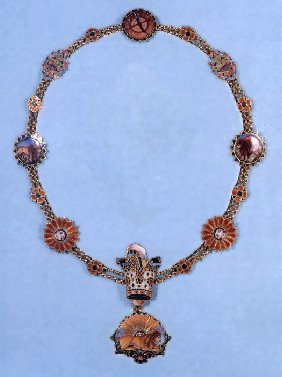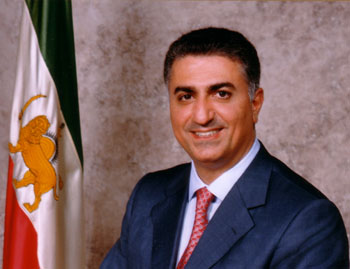
H.I.H. Crown Prince Reza Pahlavi
Iran

H.I.H. Crown Prince
Reza Pahlavi
Grand Master of
Imperial Order of
Aqdas -
Established: 1870
by Nasir
ud-din Shah, for the foundation
of this order are many and varied. Firstly, the craving for jeweled insignia by
senior officials could not be easily satiated by the Decoration of the Imperial
Portrait, an award limited to small numbers and sparingly conferred by the Shah.
Secondly, the bestowal of the Order of the Lion and Sun had increased to such a
degree that its reputation had diminished significantly. Thirdly, the Shah had
long been planning to visit the great European courts where he was expecting to
receive the highest orders available from his hosts, indeed he had already
received several high orders of chivalry. However, it was quite evident that he
had nothing of equal standing to bestow on his brother monarchs, thus raising
the prospect of certain diplomatic embarrassment. Consequently, Nasir ud-din
Shah founded this new order in three classes in 1287 AH (1870 AD).
From the outset, the Shah to limit awards of the order, to those who performed
meritorious actions of the highest importance, or were deserving of the highest
esteem of their sovereign.
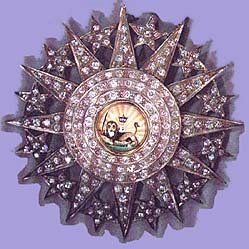
Order of Pahlavi - Established: 1932 by Reza Shah, as the premier order of the Pahlavi dynasty. The order came in two classes (Grand Collar and Grand Cordon). The Grand Collar restricted to the Shah, the Crown Prince and foreign Heads of State. The Grand Cordon limited to Iranian and foreign princes. Although the Grand Cordon was restricted to males, at least one award to a female has been recorded, to Queen Fawzieh on the birth of Princess Shahnaz in 1940.
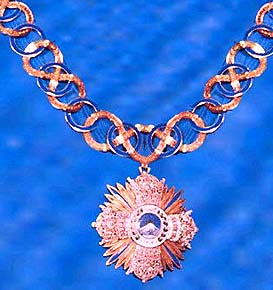 Collar,
Collar, 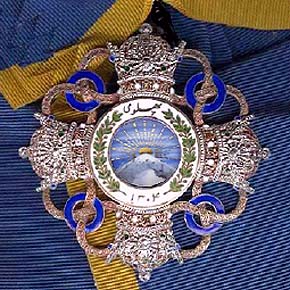 Grand Cordon
Grand Cordon
Order of Zulfikhar - Established: 1856 by Nasir ud-din Shah, as the Portrait of the Commander of the Faithful Decoration (Nishan-i-Tamtal-i-Amir ul-Mumenin) and revived under Ahmad Shah on 11th August 1922. Renamed and modified by Reza Shah Pahlavi on 10th April 1925. The conditions for award were gallantry in action, and exceptional courage, which sustained injury or resulted in death. After the institution of the Order of Sipah, the Zulfikhar was restricted to services in foreign conflicts only. Nevertheless, the Zufikhar served as the foremost military decoration during the entire Pahlavi era.
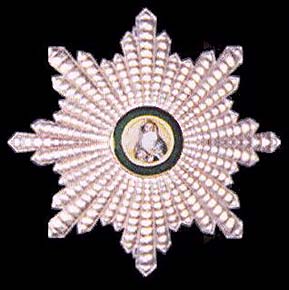
Imperial Order - Established: 15th February 1939 by H.I.M. Reza Shah Pahlavi. It served as a general order of merit rewarding military and civil services to the Shah and to the Empire. There were five classes (1. First class or Grand Cordon, 2. Second class, 3. Third class, 4. Fourth class and 5. Fifth class). Although essentially a new order the Humayun maintained many of the features of the obsolete Order of the Lion and Sun. This order did not possess a collar.
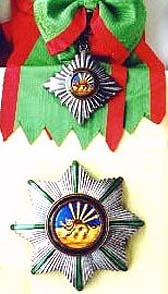
Imperial Order of the Lion and Sun -
Established: 1808 by Fath 'Ali Shah, as
the domestic counterpart to the Order of the Sun. Originally intended as a
reward to his own subjects, particularly those serving in the military units
recently reformed by French advisers. However, he extended the order to
foreigners, after the British Envoys, refused the Order of the Sun, because he
had been conferred it the Bonapartist enemy.
The order originally consisted of three classes. The first class equivalent to
the Knight Grand Cross of a British order of chivalry. The second class,
equivalent to Knight Commander. The third class, equivalent to Companion.
